Description
Therapeutic indications:
Lee-flox 0.5% eye drops are indicated for the topical treatment of bacterial external ocular infections in patients ≥1 year of age caused by levofloxacin susceptible microorganisms. Consideration should be given to official guidance on the appropriate use of antibacterial agents.
Levofloxacin is indicated in adults, children aged ≥1 to 12 years and adolescents aged 12 to 18 years.
Posology and method of administration:
For all patients instil one to two drops in the affected eye(s) every two hours up to 8 times per day while awake for the first two days and then four times daily on days 3 through 5.
If different topical ocular medications are used concomitantly, at least a 15-minute interval is required between instillations.
The duration of treatment depends on the severity of the disorder and on the clinical and bacteriological course of infection. The usual treatment duration is 5 days.
Safety and efficacy in the treatment of corneal ulcer and ophthalmia neonatorum has not been established.
Use in the Elderly
No adjustment of dosage is required.
Paediatric population
The posology is the same in adults and children aged ≥1 year.
The safety and efficacy of Levofloxacin in children aged ≥1 year have been established.
Levofloxacin is not recommended for use in children below age 1 year due to a lack of data on safety and efficacy.
The safety and efficacy of Levofloxacin in children aged < 1 year have not yet been established.
No data are available.
Method of administration
Ocular use.
To prevent contaminating the dropper tip and solution, the dropper tip should not come into contact with the eyelids or surrounding areas.
Contraindications:
Hypersensitivity to the active substance, to other quinolones or to any of the excipients.
Special warnings and precautions for use:
Lee-flox 0.5% eye drops must not be injected sub-conjunctivally. The solution should not be introduced directly into the anterior chamber of the eye.
Systemic fluoroquinolones have been associated with hypersensitivity reactions, even following a single dose. If an allergic reaction to levofloxacin occurs, discontinue the medication.
As with other anti-infectives, prolonged use may result in overgrowth of non- susceptible organisms, including fungi. If worsening of infection occurs, or if a clinical improvement is not noted within a reasonable period, discontinue use and institute alternative therapy. Whenever clinical judgment dictates, the patient should be examined with the aid of magnification, such as slit-lamp biomicroscopy, and, where appropriate, fluorescein staining.
Patients with external bacterial ocular infections should not wear contact lenses. Lee-flox 0.5% eye drops contains benzalkonium chloride, which may be absorbed by soft contact lenses. Eye irritation and discolouration of the soft contact lenses may also occur because of the presence of benzalkonium chloride. Contact lenses should be removed prior to instillation and may be reinserted 15 minutes following administration.
Paediatric population
The special warnings and precautions for use are the same for adults and children aged ≥1 year.
Interaction with other medicinal products and other forms of interaction:
Specific drug interaction studies have not been conducted with Lee-flox 0.5% eye drops.
Since maximum plasma concentrations of levofloxacin after ocular administration are at least 1000 times lower than those reported after standard oral doses, interactions mentioned for systemic use are unlikely to be clinically relevant when using Lee-flox 0.5% eye drops.
Paediatric population
No interaction studies have been performed.
Pregnancy and lactation:
Pregnancy
There are no adequate data from the use of levofloxacin in pregnant women. Animal studies do not indicate direct or indirect harmful effects with respect to reproductive toxicity. The potential risk for humans is unknown. Lee-flox 0.5% eye drops should be used during pregnancy only if the potential benefit justifies the potential risk to the foetus.
Breastfeeding
Levofloxacin is excreted in human milk. However, at therapeutic doses of Levofloxacin no effects on the suckling child are anticipated. Lee-flox 0.5% eye drops should be used during lactation only if the potential benefit justifies any potential risk to the nursing child.
Fertility
Levofloxacin caused no impairment of fertility in rats at exposures considerably in excess of the maximum human exposure after ocular administration.
Effects on ability to drive and use machines:
Levofloxacin has minor influence on the ability to drive and use machines.
If there are any transient effects on vision, the patient should be advised to wait until this clears before driving or operating machinery.
Undesirable effects:
Approximately 10 % of patients can be expected to experience adverse reactions. The reactions are usually graded as mild or moderate, are transient, and are generally restricted to the eye.
As the product contains benzalkonium chloride, contact eczema and/or irritation may be due to the active component or to this preservative.
The following undesirable effects assessed as definitely, probably or possibly related to treatment:
Immune system disorders
Rare (≥1/10,000 to <1/1,000): extra-ocular allergic reactions, including skin rash
Very rare (< 1/10,000), not known (cannot be estimated from the available data): anaphylaxis
Nervous system disorders
Uncommon (≥1/1,000 to <1/100): headache
Eye disorders
Common (≥1/100 to <1/10): Ocular burning, decreased vision and mucous strand.
Uncommon (≥1/1,000 to <1/100): Lid matting, chemosis, conjunctival papillary reaction, lid oedema, ocular discomfort, ocular itching, ocular pain, conjunctival injection, conjunctival follicles, ocular dryness, lid erythema, and photophobia.
No corneal precipitates were observed in clinical studies.
Respiratory, thoracic and mediastinal disorders
Uncommon (≥1/1,000 to <1/100): rhinitis
Very rare (< 1/10,000), Not known (cannot be estimated from the available data): Laryngeal oedema
Paediatric population
Frequency, type and severity of adverse reactions in children are expected to be the same as in adults.
Overdose:
The total amount of levofloxacin in a bottle of eye drops is too small to induce toxic effects after an accidental oral intake. If considered necessary, the patient can be observed clinically and supportive measures can be undertaken. After a local overdose with Lee-flox 0.5% eye drops, the eyes can be flushed with clean (tap) water at room temperature.
Paediatric population
Actions to be taken in case of overdose are the same in adults and in children aged ≥1 year.
Pharmacological properties:
Pharmacodynamic properties
Levofloxacin is the L-isomer of the racemic drug substance ofloxacin. The antibacterial activity of ofloxacin resides primarily in the L-isomer.
Mechanism of action
As a fluoroquinolone antibacterial agent, levofloxacin inhibits bacterial type II topoisomerases—DNA gyrase and topoisomerase IV. Levofloxacin preferentially targets DNA gyrase in Gram-negative bacteria and topoisomerase IV in Gram-positive bacteria.
Mechanisms of resistance
Bacterial resistance to levofloxacin can develop primarily due to two main mechanisms, namely a decrease in the intrabacterial concentration of a drug, or alterations in a drug's target enzymes. Target site alteration results from mutations in the chromosomal genes encoding the DNA gyrase (gyrA and gyrB) and topoisomerase IV (parC and parE; grlA and grlB in Staphylococcus aureus). Resistance due to low intrabacterial drug concentration follows either from altered outer-membrane porins (OmpF) leading to reduced entry of fluoroquinolones in Gram-negative bacteria or from efflux pumps. Efflux- mediated resistance has been described in pneumococci (PmrA), staphylococci (NorA), anaerobes, and Gram-negative bacteria. Finally, plasmid-mediated resistance to quinolones (determined by the qnr gene) has been reported in Klebsiella pneumoniae and in E. coli.
Cross-resistance
Cross-resistance between fluoroquinolones may occur. Single mutations may not result in clinical resistance, but multiple mutations generally do result in clinical resistance to all drugs within the fluoroquinolone class. Altered outer- membrane porins and efflux systems may have a broad substrate specificity, targeting several classes of antibacterial agents and leading to multiresistance.
Breakpoints
MIC breakpoints separating susceptible from intermediately susceptible organisms and intermediately susceptible from resistant organisms according to breakpoint of EUCAST (European Committee on Antimicrobial Susceptibility Testing) are as follows:
Pseudomonas spp., Staphylococcus spp., Streptococcus A,B,C,G: Susceptible ≤ 1 mg/L, resistant > 2 mg/L
Streptococcus pneumoniae: Susceptible ≤ 2 mg/L, resistant > 2 mg/L
Haemophilus influenzae, Moraxella catarrhalis: Susceptible ≤ 1 mg/L, resistant > 1 mg/L
All other pathogens: Susceptible ≤ 1 mg/L, resistant > 2 mg/L
Antibacterial spectrum
The prevalence of acquired resistance may vary geographically and with time for selected species and local information on resistance is desirable, particularly when treating severe infections. Therefore the information presented provides only an approximate guidance on probabilities as to whether microorganisms will be susceptible to levofloxacin or not. As necessary, expert advice should be sought when the local prevalence of resistance is such that the utility of the agent in at least some types of infections is questionable.
Only those bacterial species that are commonly responsible for external ocular infections, such as conjunctivitis, are presented here in the following table.
Antibacterial spectrum – susceptibility category and resistance characteristics according to EUCAST
Category I: Commonly susceptible species
Aerobic Gram-positive micro-organisms
Staphylococcus aureus (MSSA)*
Streptococcus pneumoniae
Streptococcus pyogenes
Viridans group streptococci
Aerobic Gram-negative micro-organisms
Escherichia coli
Haemophilus influenzae
Moraxella catarrhalis
Pseudomonas aeruginosa (Community isolates)
Other micro-organisms
Chlamydia trachomatis (Treatment of patients with chlamydial conjunctivitis requires concomitant systemic antimicrobial treatment)
Category II: Species for which acquired resistance may be a problem
Aerobic Gram-positive micro-organisms
Staphylococcus aureus (MRSA)**
Staphylococcus epidermidis
Aerobic Gram-negative micro-organisms
Pseudomonas aeruginosa (Hospital isolates)
* MSSA = methicillin-susceptible strains of Staphylococcus aureus
** MRSA = methicillin-resistant strains of Staphylococcus aureus
Resistance data presented in the table are based on the results of a multicentre surveillance study (Ophthalmic Study) on the prevalence of resistance among bacterial isolates obtained from patients with eye infections in Germany, June – November 2004.
Organisms have been classified as levofloxacin-susceptible based on in-vitro susceptibility and plasma concentrations reached after systemic therapy. Topical therapy achieves higher peak concentrations than found in plasma. However, it is not known if or how the kinetics of the drug after topical application to the eye may modify the antibacterial activity of levofloxacin.
Paediatric population
Pharmacodynamic properties are the same in adults and children aged ≥1 year.
Pharmacokinetic properties
After ocular instillation, levofloxacin is well maintained in the tear-film.
In a healthy-volunteer study, mean tear-film concentrations of levofloxacin measured four and six hours after topical dosing were 17.0 and 6.6 µg/mL, respectively. Five of six subjects studied had concentrations of 2 μg/mL or above at 4 hours post dose. Four of the six subjects maintained this concentration at 6 hours post dose.
Levofloxacin concentration in plasma was measured in 15 healthy adult volunteers at various time points during a 15-day course of treatment with Lee-flox 0.5% eye drops solution. The mean levofloxacin concentration in plasma 1 hour post-dose ranged from 0.86 ng/mL on Day 1 to 2.05 ng/mL on Day 15. The highest maximum levofloxacin concentration of 2.25 ng/mL was measured on Day 4 following 2 days of dosing every 2 hours for a total of 8 doses per day. Maximum levofloxacin concentrations increased from 0.94 ng/mL on Day 1 to 2.15 ng/mL on Day 15, which is more than 1000 times lower than those reported after standard oral doses of levofloxacin.
As yet, the plasma concentrations of levofloxacin reached after application to infected eyes are not known.
Storage:
Store at a temperature not exceeding 30°C, in a dry place.
PACKAGE:
A carton box containing (HDPE) plastic white dropper and white (HDPE) plastic cap containing
5 ml solution with transparent (LDPE) plastic nozzle + insert leaflet.
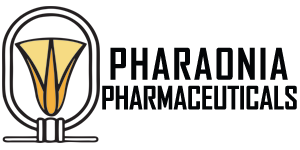

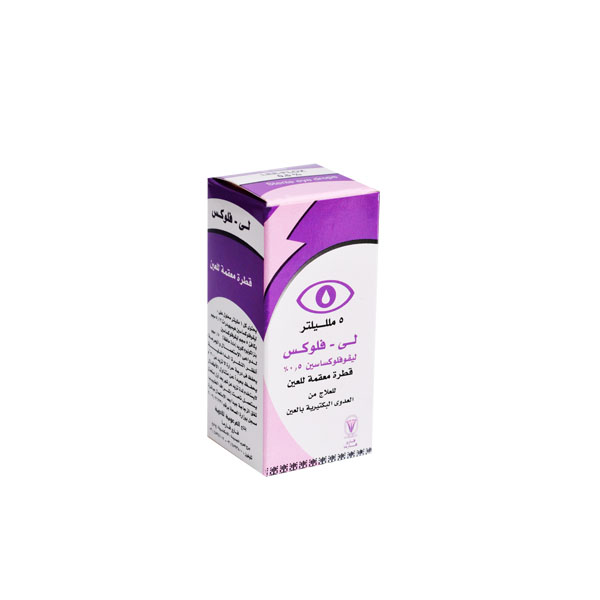
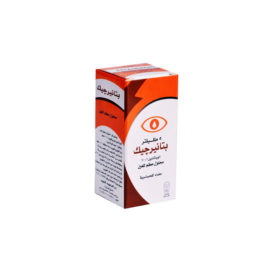
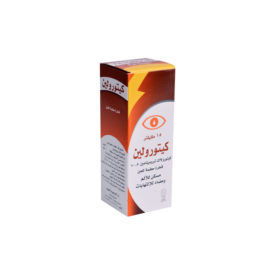

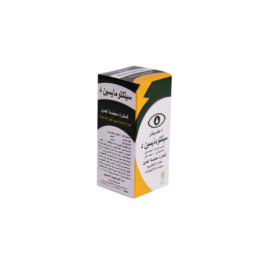
Reviews
There are no reviews yet.